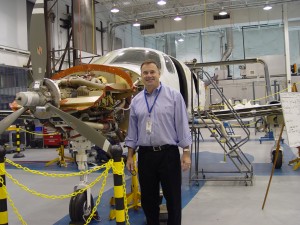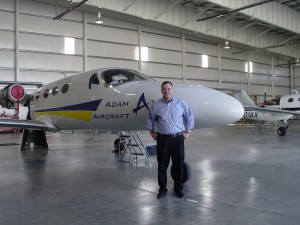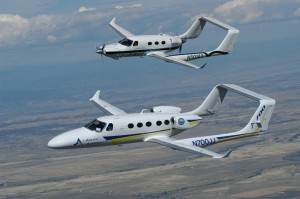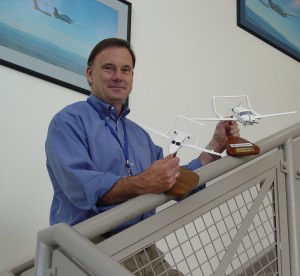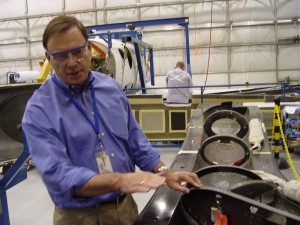By Di Freeze
Throughout history, the essence of entrepreneurship has often been shrouded in a veil of mystery and a general misunderstanding of what exactly it is. While academic research has not brought about an entirely complete definition, it has assembled an extensive list of characteristics; among them are three that seem to be most prevalent to successful entrepreneurs. They are an unrelenting belief in themselves, unquestionable focus on their business, and a practical appreciation of their own strengths and weaknesses.
In the tradition of pioneers such as Howard Hughes, William Lear, Walter and Olive Ann Beech, and Orville and Wilbur Wright, George F. “Rick” Adam Jr. not only has the characteristics of an entrepreneur, but the foresight of a true industry visionary.
Rick Adam is the recipient of the Airport Journal’s 2003 Michael Chowdry Memoriam Aviation Entrepreneur of the Year award. Adam is the founder, CEO and chairman of the board of Adam Aircraft Industries, an aircraft manufacturer that is steadily gaining recognition in the industry for their leadership, advancements, and ingenuity in bringing the next generation of aircraft to market.
Over the last five years, the industry has noted that Adam isn’t afraid to challenge the established methods of building and certifying aircraft, while developing his family of general aviation aircraft. AAI, changing the way aircraft is brought to market, implements innovative management techniques and employs advanced manufacturing processes using composite materials.
By shortening the time to develop and certify new aircraft, AAI is minimizing costs and preparing to deliver high-performance, attractively priced aircraft.
Over the course of the next three years, Adam Aircraft expects to deliver 125 aircraft, each requiring approximately 10,000 labor hours to build. The aircraft family right now includes the A500, a six-place pressurized, twin-engine aircraft with centerline thrust, and a follow-on light jet, the A700 AdamJet, which is currently in test flight and development.
Rick Adam
George F. “Rick” Adam Jr. was born June 29, 1946, in Pasadena, Calif. All through his youth, he knew he wanted to be a pilot, but he didn’t begin flying until a decade ago.
“When you’re young, you want to fly and you have time but no money, and then you get a little older, and you have the money, but no time,” he said. “It took until 1992 to have time and money at the same time.”
When he did finally get his private pilot’s license, it didn’t take long before he began buying his own business aircraft. Also, he co-acquired a DC-3 with Pat Wiesner, founder of Wiesner Publications, with whom he co-founded the Rocky Mountain Aviation Foundation. Until they recently sold it, donating the money to Wings Over the Rockies Air & Space Museum, the DC-3 was used for scenic flights, special events and charitable causes.
The passion for aviation is definitely in Adam’s genes. George Adam Sr. grew up during the Depression in North Dakota. After graduating high school, his mother sent him off to the Civilian Conservation Corps, which was building roads in Yellowstone National Park. In 1938, when he turned 18, he enlisted. A year later, he trained at Lowry Field in Denver where he was a machine gun armorer on the P-40 Warhawk. After a transfer to Long Beach, he got into a P-38 squadron as an armorer. When the military became desperate for pilots, they began asking enlisted personnel to attend Officer Candidate School., and Adam Sr. took the military up on its generous offer and became an officer, eventually flying the B-17 and B-29 in World War II.
But that wasn’t Rick Adam’s only inherited passion for aviation. He smiles when he tells how his parents met.
“My dad was in Las Vegas training B-17 pilots, and they were so short on fuel that they would take a B-17 and fill it up,” he said. “They would have two or three crews onboard, a couple of navigators, a couple of bombardiers, and they’d also have gunners onboard, because they practiced everything during their mission.
“On one particular mission over Bakersfield, my father lost an engine, which wasn’t really that big of a deal, because they’d just land on three engines, instead of four. But the place they put it down was where they were training all of these women pilots. My dad calls back to the base and he says, ‘What do you want me to do?’ The commander says, ‘Well, you stuck it in there, you get it back out of there.'”
They piled all the extra pilots, navigators and crewmembers into the back of a truck and sent them back to Las Vegas.”
Adam Sr., the copilot and the flight engineer took off with three engines and brought it back to Las Vegas.
“About two weeks later, he’s walking down the sidewalk in Las Vegas, and my mom’s there with her flight training crew, because they had liberty for the weekend. She says, ‘Aren’t you that pilot that put that crippled B-17 down into Bakersfield?’ He said, ‘Yeah. That was me.'”
Adam said that his mom went through primary flight training and got her flight license, in order to be a ferry pilot in World War II, but that all changed when she married Adam Sr.
“My dad talked her out of ferrying planes,” he said. “He just wanted her to be a wife.”
Adam grew up on Air Force bases around the world, and it didn’t take him long to decide he wanted to attend the U.S. Air Force Academy, but a color vision deficiency kept him out, since he couldn’t qualify for flight training. Instead, he entered the U.S. Military Academy at West Point. Adam explained that the fact that he was labeled “service connected” gave him better options. He eventually applied for an inter-service transfer and switched his U.S. Army commission to the Air Force.
“I still couldn’t fly because of the color vision thing, but I was at least back in the Air Force,” he said.
After learning computer science, Captain Adam, as a launch crew officer, eventually ran the Real Time Computer Centers at the Kennedy Space Center and Vandenberg Air Force Base, during the period of Apollo missions 8 through 14. Adam was at Cape Kennedy for three years and at Vandenberg for two.
While in the Air Force, he attended Florida State University and Golden Gate University, where he received his MBA. After his five years in the Air Force, he worked in the information technology departments of Baxter Healthcare Corp., FMC, Litton Industries, and IBM. From there he went to Wall Street, where he ran the IT department at Goldman Sachs, the prestigious New York investment firm. He later became a general partner, and founded the Goldman Sachs Trust Co., Global Custody Business and Securities Lending Business.
Adam decided to retire from the firm in 1992.
“When I told them I was retiring, they asked me if I would give them a year of transition,” Adam said.
That meant that every other week he would be in New York. Adam had been planning what he would do with the alternate week for a long time.
“I spent it taking flying lessons here at Centennial Airport,” he said. “I essentially became a fulltime student pilot. In a year, I went through private, multiengine and instrument ratings.”
In late 1993, Adam formed New Era of Networks, an integration software company based near the airport. Forming the company was one reason Adam would begin looking to manufacture aircraft. The other had been his surprise at finding only elderly aircraft when he was learning to fly.
“As soon as I started my software company, every time I had a business trip, I’d fly myself,” he said. “I flew back and forth to New York hundreds of times. I accumulated 1,500 hours almost overnight.”
Adam first acquired a Cessna 337 Skymaster, before moving to a Mitsubishi MU2, and then ultimately stepping up to a CitationJet, in which he was type-rated.
“In about six or seven years, I built up well over 1,000 hours, just flying myself on business trips,” he said.
He sold it, and says he now owns a Citation VII that came out of the Internet bubble.
“I’ve been trying to sell it for three years, but the market is kind of soft,” said Adam. “I don’t fly it anymore. I have it up at a charter operator at Jeffco.”
When pondering why there wasn’t a more broad choice in aircraft, Adam said he didn’t think it made sense.
“If it’s cars or boats or hot tubs or anything, the way our economy works, you have hundreds and hundreds of choices; in airplanes, there are very few,” he said. “Whenever I could find anybody who thought they knew anything about it, I’d ask, ‘Why do you think there aren’t more airplanes?'”
Adams said that over a period of about four or five years, he had many responses, such as, “There were too many lawsuits,” “The FAA has tightened up regulations,” and “Labor cost has gone up and it’s hard to make money.”
Some companies had faced harder times than others.
“Mooney and Piper went bankrupt for a while,” he said. “They just didn’t have any money to build new airplanes.”
To add to his growing knowledge base, and simply because he loved aviation, Adam read 10 to 30 airplane magazines per month. He soon became fascinating with kit planes being built in garages.
“There were real swoopy-looking aerodynamic and modern looking aircraft,” he said. “Rutan did it. Lancair did it. Cirrus had a kit. Stoddard Hamilton had a kit. Europa had one. There were probably 20 or 30 kit companies. Some may have only made one or two or three. But when you looked at them, they looked modern.”
Then, in about the mid-1990s, Adam said a couple of the kit companies attempted to get their kit planes certified by the FAA. Cirrus and Lancair both succeeded.
“So, I’m watching this,” said Adam. “And, now the key to all the newcomers is they’re using composites instead of aluminum. They’re using carbon fiber, fiberglass, or some kind of combination.”
While Adam was watching all this happen, he began thinking that if someone studied hard enough and worked hard enough, that person could bring new modern airplanes to the market.
“And there were a lot of market surveys around that said that at the time,” he said.
Adam’s initial thought was to build a single engine, because it would be easier to manage from a manufacturing standpoint. But, Cirrus and Lancair beat him to the punch. That left a twin as his choice. He thought he might do that, and combine value, groundbreaking technology and safety, with sleek modern looks. He definitely wanted carbon fiber. But there were other decisions to make.
While he thought about it, he recalled a joke often repeated by single-engine pilots.
“When you start flying twins, the joke is that you’re paying for two engines, but you only ever use one, because 95 percent of twin training is what you do when you lose an engine—engine-out stuff,” he said. “In a traditional airplane, the engines are out on the wing. If one engine quits, the good engine wants to spin the airplane. So, you go up with your instructor pilot day after day after day, and he pulls one of the engines back, and the airplane starts to go around. You get up on the rudders, and you straighten it out. Frankly, it’s a lot more exciting than you like when you’re a student pilot.”
That was what initially led Adam to the Cessna 337 Skymaster.
“It had an engine in the front and in the back,” he said. “The whole purpose of in-line thrust, or centerline thrust, is that if you lose an engine, the good engine keeps you flying straight.”
In the mid-nineties, Adam finally committed himself to entering the airplane building business. He would build a modern looking in-line twin, and in the process, he would solve the asymmetrical thrust problem.
Adam said that when he first got the idea of building and selling aircraft, there were some things he thought would be easier to accomplish than others.
“The aerodynamics is hard, but it’s not that hard; raising money is hard, but it’s not that hard,” he said. “What’s really hard here is the FAA.”
That’s why he turned to John Knudsen, an FAA attorney, for help.
“You can’t sell airplanes unless you get them certified,” Adam said. “Unfortunately it’s a very long, detailed process. I knew John socially. Every time we’d get to a barbecue or cocktail party, we’d talk about how great it would be if we built airplanes someday. I still had a full-time job in the software business, but I really wanted to get this thing moving, so I asked John if he would leave his law job and get us started.”
In 1998, when Adam Aircraft was founded, Knudsen became president. That year, Adam went to see industry icon Burt Rutan at Scaled Composites in Mojave, Calif. He said they paid him a shade over a million dollars to engineer their prototype, build it and get it flying.
“The first year the Eclipse showed up at Oshkosh, they spent a million dollars for their marketing launch,” he said. “We put our money into engineers and aircraft and learning how they fly.”
Rutan had built several jets by then and according to Adam, they all looked great—”ultra modern with big, swoopy noses and nice windshields.” Adams told Rutan that the new design should be a propeller plane, but it should look as much like a jet as possible.
“So, even if there’s a propeller in the front, make the front end of it look jet-like,” Adam told Rutan.
Rutan took the design concept to prototype in just seven months. He dubbed the proof-of-concept aircraft the M309 because it was the 309th design to come off his drawing board, and the designation stuck. It was later named the CarbonAero. Initial flight-testing of the sleek, proof-of-concept aircraft began in March 2000. The Adam POC flew for more than 300 flight hours, producing valuable test data on handling, longitudinal stability, flight controls and engine performance. This testing also demonstrated the safety of inline thrust with no critical (or VMC) engine concerns. The POC was taken to several air shows to get customer feedback.
“For example, you go to this air show and this guy says, ‘This is going to cost about a million bucks; I’m not asking my wife to get up on the wing to get in here; you have to get me an airstair door,'” Adam said. “And they’d like it a little bigger.
“After two years of doing that, I was sure there was a market for this, so we put this building up and we hired a bunch of engineers, and we started building them.”
With his passions elsewhere, Adam would soon be out of the software business. In 1999, NEON was ranked seventh nationally on Deloitte & Touche’s Technology Fast 500 list, earning Adam the Ernst & Young Entrepreneur of the Year award for the Rocky Mountain Region. After taking the company public, Adam sold it to Sybase, a database company, in July 2001, for 400 million dollars. For a while, he remained as the vice president of the company’s e-Business platform.
Adam dropped $30 million into funding his aircraft manufacturing dream. He also hired a couple of guys to take the M309 around to air shows, in search of customer feedback.
The A500
By May 2002, AAI had already secured deposits for over 40 deliveries for the A500. Improvements and modifications of the M309 were incorporated into the final design. On July 11, 2002, A500 s/n 001, the first of four test aircraft built with production tooling at the company’s 55,000-square-foot manufacturing facility, took its maiden flight from Centennial Airport, piloted by Glenn Maben, chief test pilot, and Bruce Barrett, flight test designated engineering representative. The flight occurred just nine months after the first carbon composite airframe parts for s/n 001 were produced.
Ten days later, the FAA granted the Adam A500 an expanded operating permit to allow it to fly to Oshkosh. By the time it departed on July 21, Barrett, Maben and Steve Martin had logged several hours on the aircraft.
In September 2002, NASA, in partnership with the FAA, invited Adam Aircraft to participate in a demonstration of their new Small Aircraft Transportation System Program. Under the project, NASA initiated a five-year $69 million research program that would develop and evaluate new technologies and operating procedures in ground and flight research at several airports around the country, culminating in technology flight demonstrations by mid-2005. The purpose of the SATS program is to develop, integrate and demonstrate new and affordable technologies that enable equitable, on-demand, near-all-weather accessibility of small aircraft to community airports, with the resulting transportation system providing a safe, point-to-point, widely distributed, cost-effective and timesaving alternative for widespread use.
That same month, AAI announced they would certify their own aircraft seats.
“We got bids on seats, and the lowest bid we got was a million and a half dollars for engineering,” Adam said. “We just thought that was too much, so we did it ourselves for under $200,000.”
And, they also announced the FAA had awarded them ODAR (Organizational Designated Airworthiness Representative) status. The status denotes recognition that the FAA has approved the manufacturer’s organization, processes and qualified staff members authority to perform conformity inspections for manufacturing processes and aircraft parts as directed by the FAA. Without ODAR status, an aircraft manufacturer must depend on a Designated Airworthiness Representative (DAR) to perform inspections on behalf of the FAA, but few exist in the metro area and many offer limited availability. With ODAR, in-house personnel can perform conformity inspections, improving flexibility, access, and efficiency in the company’s aircraft manufacturing operations.
The A700
Adam says that over the years, power plants have controlled aviation.
“You can’t do something new and innovative unless you have the power plant,” he said.
For the A500, they selected two Continental piston engines because at the time, they felt it was the “safest thing to do.”
“The engines had been around for 40 years and spare parts were plentiful, making the risk somewhat minimal,” he said.
Adam said it was always their thought that the next aircraft in the family would be a turboprop jet engine driving a propeller, because it’s pretty close to the A500. However, in the spring of 2002, Williams International approached Adam about being the commercial launch customer for their new FJ33, rated at 1,200 pounds of thrust each and derived from the well-proven FJ44.
“Instead of going to the turboprop next, we took a look at jumping all the way up to the fanjet,” said Adam. “Our engineers concluded that it would be pretty easy to extend the design out to that. And that’s what we did.”
The Williams engine will be certified by the end of the year.
Adams explained that first Williams, and then Pratt & Whitney, ventured into building cost-effective, light turbofan engines—essentially, miniature jet engines.
“That’s what’s required to launch the air taxi business,” said Adam. “You need airplanes that cost between $1 million and $2 million and are safe. To really make that happen, you need this new family of jet engines.”
Today, said Adam, there are about 10 companies that have placed themselves in the light jet business, and half of them have selected Williams, the other half Pratt.
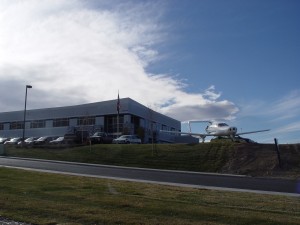
The M309 proof-of-concept aircraft, designed by Burt Rutan, in front of Adam Aircraft, Industries headquarters near Centennial Airport.
“The Williams engine is a couple of years ahead of Pratt, simply because it started earlier,” Adam said.
AAI announced the A700 in October 2002, and their intention of being first to market in the light jet category. A month later, the A500 reached the 100-hour mark in the developmental testing phase, after completing 50 test flights.
In December 2002, AirScan, which currently operates a fleet of Cessna Skymasters, ordered 30 Adam A500 aircraft, which they will use in government contract airborne surveillance and security fleet operations.
A500 s/n 002 took its first flight on Feb. 13, 2003. As of that time, the company had approximately 100 direct orders, options and dealer commitments for the A500.
That same month, AAI, committed to staying in Colorado, announced their expansion to Pueblo, which Adam said, with its excellent workforce, airport and facilities, provides a first-rate solution for Adam’s long-range growth strategy. It helped immensely that Puebloans had a “welcoming attitude.”
“The City of Pueblo gave us so much economic help,” he said.
Adam said that the City of Pueblo put together a very effective program, and provided significant assistance in capital equipment needs for the new plant, as did PEDCO. AAI was given immediate access to a 30,000-square-foot manufacturing facility at the airport; the building was in immediate move-in condition.
In April 2003, GS Capital Partners 2000, L.P., a private equity investment fund managed by Goldman, Sachs & Co., made a significant investment in the company. “Having Goldman Sachs invest in our company is a tremendous benefit,” Adam said. “In addition to access to capital, we will benefit from Goldman’s knowledge of the aviation industry and their overall business expertise.”
The investment also meant something else for Adam, who, up to that point, hadn’t flown the A500.
“I did not fly it in the early days because I was too busy raising money,” he said. “If I disappeared, the company would have a problem. My commitment was that when I got the company fully funded, I would fly it. Goldman bought 20 percent of the company; the day that money was wired into the company, I went out and flew the plane. It flies great.”
Adam said he believes the investment validates the market potential of his company’s two products.
Also in April 2003, Adam AAI appointed European dealer Rheinland Air Service as designated dealer to sell and service the Adam family of aircraft. The agreement will include the sales and service responsibilities of both the A500 twin-engine pressurized piston and the A700 AdamJet in Germany, Austria, Belgium, Netherlands, and Luxembourg.
On July 27, 2003, the Adam A700, piloted by Bruce Barrett and Glenn Maben, made its maiden flight, marking the first flight of a light jet with production engines.
“That takes a lot of risk factors out of our program,” Adam said.
Certification and first aircraft delivery of the AdamJet are scheduled for the end of 2004.
On Saturday, Nov. 15, 2003, AAI met another goal when they ran up the engines on A500 s/n 003.
“It’s getting close to being finished, but it’s not ready to fly yet,” Adam said. “Two weeks from now, s/n 003 will go airborne.”
That meant they were incredibly close to certification for the A500.
“We’ll do a few weeks of flight testing, and then we’ll ask the FAA to get in it, and start doing their final flight testing,” Adam said.
Although Eclipse, Cessna, Avocet, Safire and Diamond Jet have all proclaimed themselves manufacturers of personal jets, only AAI is flying a light jet today.
“You can see how much faster we’re going than the other guys,” he said. “We have about $50 million total in the program now, and we have two planes flying, including a near-production jet.”
“Eclipse flew for a little while, but was decommissioned last week,” said Adam.
A500 s/n 002 has about 350 hours of flight on it, and A700 s/n 00 1 has about 90 hours of flight test on it.
Although it seems like they’ve been walking pretty fast, Adam said that Adam Aircraft has got to where they are by taking “baby steps.”
“We didn’t try to build a jet first off,” he said. “That would have been too hard. So, we built the A500, and we figured out how to extend it to the A700.”
Two 350 hp Teledyne Continental TSIO-550 E engines power the A500, which sells for $895,000. The A500 has a maximum gross weight of 6,300, a maximum range of 1,470 nm, and an estimated 250-knot maximum speed. The standard package includes side-stick controls, dual Garmin GNS 530s, an S-TEC 55x autopilot, and leather club seating for six. It features Full Authority Digital Engine Control, a computerized engine control system that maximizes engine efficiency resulting in fuel savings of approximately 15 percent. Avidyne Corporation will supply its FlightMax Entegra integrated flight deck for the Adam A500.
With a 340 knot cruise speed (391 mph), 41,000 foot ceiling and 1,400 nautical mile range, the six-place AdamJet, priced at $1,995,000, will provide the performance of existing entry-level jets at a fraction of the cost. The A700’s body is about 30 inches longer and the jet has a full-width aft lavatory. It features the Avidyne Entegra flight deck with three large displays. An Avidyne Primary Flight Display was on board for the A700’s first flight. Adam predicts that the A700 will be a key building block for future air taxi and fractional aircraft markets.
The Manufacturing Aspect
Besides the company’s headquarters/manufacturing facility, AAI occupies an additional 20,000-square-foot assembly hangar at Willowbrook, near the airport’s taxiway. The manufacturing plant in Pueblo adds an additional 40,000 square feet. It houses a metal shop, machinists and the static test facility where the FAA breaks down aircraft parts for inspection and evaluation. They plan to duplicate their composite clean room—a limited space where contamination is controlled—and ovens in Pueblo, which he says will literally double their manufacturing capacity.
“As we grow up, we’re spreading the work out among those three sites,” Adam said.
One key company innovation is operating 24 hours a day, seven days a week.
“We have for a couple of years,” Adam said. “All of our direct labor folks work a 12-hour day. They’re on three days, then off four days. … Sunday is voluntary overtime.”
It’s planned that the body and the wing will be built at their manufacturing facilities near Centennial Airport, and the boom and the seats will be built in Pueblo and trucked up to Centennial. The hangar at Willowbrook has the capacity to build 40 or 50 A500s there, but Adam anticipates needing an additional facility to settle the A700.
AAI engineers design parts and then send the design down to a five-axis numerically controlled milling machine, which cuts out the master shape.
“That becomes the laminating tool for the mold,” Adam said. “We do all that in-house. We take that carbon cloth and we put multiple layers down in the mold. Then, we cure it in the oven for six hours, and out comes a part.”
Adam says that if you outsource aluminum tooling, a typical timeframe would be six to nine months before it comes back.
“Anyone who is in aluminum will outsource their tooling most of the time,” Adam said. “Our typical timeframe is about a week.”
He said the ability to compress the development schedule was why they opted to do their own tooling.
Besides the computer-controlling milling machine, the manufacturing facility includes a clean room for preparing carbon-fiber fabric, its own curing oven, a well-equipped machine shop and both inertial- and laser-based quality-control inspection gear.
The primary structure of both the A500 and the A700 is made of “Toray,” an epoxy-based, pre-impregnated carbon material produced by Tokyo Rayon developed specifically for aircraft applications.
“Toray feeds the Boeing factory out of that facility, and we also get ours from Seattle,” Adam said.
The thread used in the carbon fiber cloth is about one-hundredth of an inch in diameter; it’s impregnated with an epoxy, which enables all the layers to be easily glued together.
“It’s like double-sided sticky paper,” said Adam. “NASA invested in this material as part of the Advanced General Aviation Transport Experiments program. They’ve been developing it for 10 or 15 years—generally though, for about five years. Boeing is their biggest customer.”
The fuselage, says Adam, averages about 40 layers of the prepreg carbon fiber material.
“The thickest part of the wing is close to 100 layers,” he said. “The great thing about this carbon fiber cloth is you only make it as thick as you need to pass the strength test; you only put it where you need it.”
Adam points out the boom, where the edge thins noticeably.
“At the front of the boom, it takes a lot of stress; it’s hooked to the wing there, and the landing gear is in there,” Adam said. “That’s about 50 layers, almost half an inch thick. But then as you go out toward the vertical, you go out all the way to the far end, it takes less and less stress out there, and it goes down to 10 layers. It continuously varies from the front to the back. If you try to do that out of metal, there’s really no way to vary aluminum that much from front to back.”
Adam said that their process has taken thousands of part numbers out of the aircraft. As an example, he points to the composite wing, which has five large parts in it—lower wing skin, two spars, two upper wing skins—and only about 200 total part numbers.
“We cure that as one piece,” he said. “That comes out of the mold all as one assembly. Then we have a one-piece upper wing skin. We glue it together. This whole horizontal wing is two pieces, two part numbers. We’re taking literally thousands and thousands of parts out of the airplane, which saves labor and makes it lighter and more durable.”
In comparison, Adam said, a King Air wing has 2,500 part numbers.
“We reduced the part count by over 90 percent,” he said.
Utilizing His Computer Background
Adam said that his computer background relates to what he is now doing in three ways.
“One way is we have an enormous amount of computer technology here,” he said. “All the engineers are on computers, and they have very powerful design tools.”
Also, since Adam managed about 2,500 people for Goldman Sachs, and thousands of software programmers over his career, he said it wasn’t too big of a change to manage aerospace engineers.
“They’re just like software programmers,” he said. “They behave exactly the same way. They’re very creative guys. They have 99 million ways to get it done, but the thing that’s hard for them is to finish on time, just like software programmers.”
His heavy background in software design and management also helped when it came to working with the FAA, and asking for approval to email drawings to the organization.
“We’re the first company ever to do that,” he said. “Prior to this, we’d take paper over to the FAA. We email our drawings to them, and they mark them approved. Usually we get them back within a day or so. It’s a much faster process.”
Adam said the manufacturing process is fully computerized.
“All our part numbers are in the computer system; our entire inventory is in there. I think from a classical use of computers, we’ve done a really good job,” he said.
The main lesson Adam says he has taken from his time in the computer business is the principle of modern computer design, or keeping things “modular.”
“Probably the best example is the IBM PC,” he said. “The PC was designed in the eighties, but if you look at the way they’re architected today, if you have a big clunky monitor, and you don’t want that monitor, you can get rid of it and get a flat panel. You jack it in, and it works. It doesn’t change anything else in the system, because there’s a clean interface between the screen and the rest of the system. We can change out the mouse or the keyboard, the disc driver and the modem. You can take pieces in and out, and not tear up the whole system. The opposite of modular is hard-wired, where you jumble everything together, and if you change one thing, it changes everything.”
Because Adam and his team opted for carbon fiber, they picked up a cushion of a few hundred pounds, and have used that to build modularity into the airplane. He adds that their ability to use 80 percent of the parts off the A500 to create the A700 jet is a direct result of modular design.
Because of that and system commonality with the A500, the AdamJet is supported by over three years of development experience and almost 380 hours of flight testing.
The idea of a modular architecture in airplane design is very unique in airplanes. Adam’s ability to build multiple designs off of the same basic family has given him a distinctive economic advantage over other manufacturers.
Adam said that from day one they decided to build modularity into the first plane, so they could build a family of airplanes over time.
Challenges And What He Would’ve Done Differently
As far as the challenges of starting an aircraft manufacturing business, Adam said that he’d never been in a regulated business before.
“Software is really not regulated, so I had to learn a lot about how to operate in a highly regulated business,” he said. “The other thing is that coming out of the technology business, raising money was very, very easy.”
Adam said that if he had it to do all over again, he would have tried to raise capital sooner.
“We were a couple of years into it before I started raising money,” Adam said. “Next time, I’d start right away. I was very surprised at how hard it is to raise money for aviation, because so many people like aviation. However, in software, there are tons of people you could point out that have great companies and they’re successful. In aviation, there aren’t a lot of success stories. That’s made investors a little more cautious. I’ve had to work much harder at funding the company than I would’ve guessed.”
Adam said that if he had known in the beginning what he knows now, one thing he would’ve done differently would be to give Rutan slightly different specifications.
“If I went to Burt again for another design, I could give him a lot better guidance so that his first design was a lot closer to what we sell,” he said. “There’s a pretty big step between what Burt did and what we did, because we just didn’t understand what the market was. If I started over, I’d think I’d get a lot closer to the final product the first time out. Other than that, I think our engineers and everyone have done a great job.”
For more information, visit www.adamaircraft.com.












